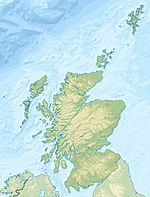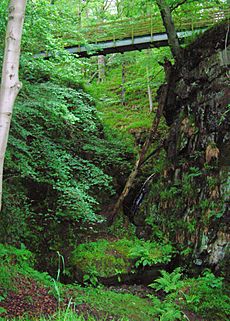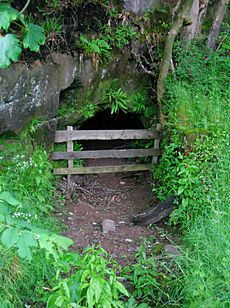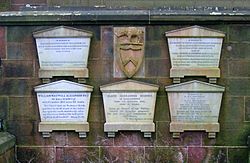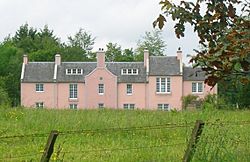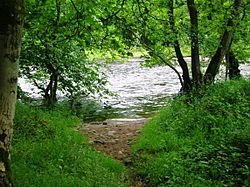Kingencleugh Castle facts for kids
Quick facts for kids Kingencleugh Castle |
|
|---|---|
| Mauchline, East Ayrshire, Scotland UK |
|
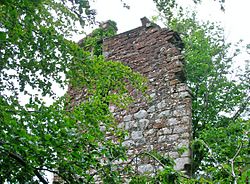 |
|
| Coordinates | 55°30′06″N 4°22′15″W / 55.501784°N 4.3708°W |
| Grid reference | NS 50351 25666 |
| Type | 'L' shaped Tower house |
| Site information | |
| Owner | Private |
| Open to the public |
No |
| Condition | Ruined |
| Site history | |
| Built | c 1620 |
| Built by | Campbells of Cessnock |
| Materials | Stone |
Kingencleugh Castle, also called Kingenclough, is an old castle ruin. It is located near the town of Mauchline in East Ayrshire, Scotland. The castle is a listed building, which means it is protected for its historical importance.
Contents
Exploring Kingencleugh Castle's Past
This castle was built mainly as a home, with defense being less important. The famous religious reformer John Knox visited the castle in 1556. Kingencleugh was one of several castles built by the Campbell family. They used these castles to mark the edges of their land.
The current castle was built around 1620. It replaced an older fort that John Knox would have known. The Campbell family owned the property until the late 1700s. The castle was left empty once a new house was built nearby.
John Knox and the Campbells
Kingencleugh Castle was home to Hugh and Robert Campbell. Both were strong supporters of the Reformation, a big religious change. George Wishart and John Knox were guests here. Knox even preached at the castle when he visited Mauchline in 1556.
When Knox was dying, he asked Robert Campbell to look after his wife and children. This shows how much he trusted Robert. A historian named Dobie wrote that John Knox preached in many places in the area. He also gave the Sacrament of Our Lord's Supper at some of these locations.
What Remains of the Castle?
The castle ruins stand above the Kingen Cleugh Glen and burn (a small stream). What is left is a four-story, L-shaped building. It was made of stone with strong walls about 0.8 meters thick. The two lower floors only have narrow slit windows.
The north-west wall still stands about 7 meters high. It has a special stepped design at the top called a crow-stepped gable. Part of a small, round tower remains where the 'L' shape meets. The main entrance is in this area. The ground floor likely had a curved, barrel-shaped ceiling. The castle was in a good spot for defense, overlooking the land that slopes to the south. A 'cleugh' in Scots means a narrow gorge or valley with high, rocky sides.
Kingencleugh Castle looks over the Lily or Kingen Cleugh Glen. A stream from this glen flows into the nearby River Ayr. There is a local story that a secret underground passage connects Mauchline Castle and Kingencleugh.
The Lily Glen and Robert Burns
The Lily Glen, or Kingen Cleugh Glen, has a small stream that flows into the River Ayr. The name "lilies" often refers to daffodils in Scotland. However, it can also mean wild garlic or bluebells. The glen is full of old woodland plants. These include woodruff, wood sorrel, and bluebells.
Local stories say that the famous poet Robert Burns used to visit this glen. He would take a dip in the Kingencleugh Burn when he lived at Mossgiel Farm. An old stone bath or cistern still exists with mossy steps leading to it. People say this was his bathing spot. Burns often visited this area. He wrote about the "Braes of Ballochmyle" in his poem The Lass of Ballochmyle. He saw the young lady in the evening near an old "Fog House."
|
The Lass of Ballochmyle
|
Old maps show a stone bath at the bottom of the Kingen Cleugh Glen. All the stream's water was sent into it. The water then left through a tunnel cut through the rock. It then ran down to the Haugh hamlet. In 1837, there was a wool mill and a corn mill here. They used water from this cistern. The water channel was tunneled through soft red sandstone. You can still see the tunnel openings and two stone bridges over the channel.
Kingencleugh House: A Newer Home
The current manor house was built around 1765. It was later rebuilt in 1957. It served as a dower house for the Ballochmyle estate. An elephant is the family crest, and you can see it above the door.
How Maps Show the Castle's History
Old maps help us trace the castle's history. Robert Gordon's map (1636–52) shows it as "Kinzancleuch." The Timothy Pont map (around 1602) calls it "Kinzankcleug." Roy's map from 1747 shows the castle as "Kings Cleugh." Armstrong's map (1775) shows the old castle ruins as "Kingincleugh" with the house nearby. Thomson's map from 1832 calls it "Kingscleugh."
Families Connected to Kingencleugh
The Campbells of Kingencleugh
The Campbell family were the first recorded owners of Kingencleugh in the 1400s. Hugh Campbell was a strong supporter of the Reformation. He is mentioned by John Knox. Robert Campbell of Kingencleugh (died 1574) was a good friend of John Knox. He was with Knox during his final illness.
Robert Campbell had a daughter named Elizabeth. She inherited the lands and castle in 1586. She had a son named John.
A poem about Robert and Elizabeth Campbell says:
|
John Campbell of Kingencleugh became the owner in 1627. His son, also named John, married Agnes Craufurd. They had two sons, Hugh and George, and a daughter. Hugh inherited the property. His son John inherited it next. This John's heir was another John, who was a dedicated church elder. He died around 1752. His daughter married a Mr. McGill, but they had no children.
Hugh Campbell of Kingencleugh was a strong supporter of the Reformation. Around 1539, soldiers tried to stop George Wishart from preaching at Mauchline church. Hugh Campbell and others wanted to force their way in. But Wishart chose to preach outside instead. The Campbells of Kingencleugh are mentioned in records until the late 1700s.
The Alexanders of Ballochmyle
When the last Campbell owner, Mrs. McGill, died, Mr. Alexander of Ballochmyle bought the property. The Alexander family later became the Hagart-Alexander Baronets. Sir Claud Hagart-Alexander, the 4th Baronet, now lives at Kingencleugh House. The family moved there after leaving Ballochmyle House, which they had bought in 1785.
A Legend of Kingencleugh Castle
In 1253, a knight named Sir Percy Seton fell in love with Mona. She was the daughter of Cormac of the Cleugh, the Laird of Kingencleugh. Cormac was known as the "King of the Cleugh" or the "Hunter King." He refused to let Sir Percy marry Mona. Cormac loved hunting wild boar. He kept the skins and heads of his kills in a castle vault.
One day, while hunting, Cormac found a huge, fierce boar. This boar killed all his hunting dogs. Cormac tried to force his head huntsman to go into the boar's den. When the huntsman refused, Cormac hit him with his spear. The huntsman fell into the den and was killed by the boar.
Cormac was superstitious. He believed the ghost of the dead huntsman and the boar haunted the castle vault. Sir Percy came up with a plan. He would use the secret tunnel between Mauchline Castle and Kingencleugh. Mona knew about the plan. She made sure her forced wedding to a man her father chose was near the vault.
At a key moment in the ceremony, the bloody ghost of the huntsman seemed to burst from the sealed vault! The ghost grabbed the bride. But it secretly carried her away to Mauchline Castle, through the tunnel, into the arms of her true love, Sir Percy.
Interesting Facts About the Area
Lady Cecilia Brabazon, who was Mr. Alexander of Ballochmyle's aunt, lived for many years in a cottage near the old castle tower.
Miss Wilhelmina Alexander of Ballochmyle is the "Bonnie Lass of Ballochmyle" from Robert Burns' poem. He saw her near Ballochmyle House. Wilhelmina never married. She kept the poet's letter and poem manuscript her whole life.
The lands of Over and Nether Haugh became known as Kinzeancleuche or Kingencleugh.
A prisoner of war camp was located at Kingencleugh during wartime.
Robert Burns' father-in-law is said to have helped build the old Howford Bridge in 1750. This bridge is below Catrine House.
The famous Ballochmyle cup and ring marks are ancient stone carvings found on the estate.
Images for kids


